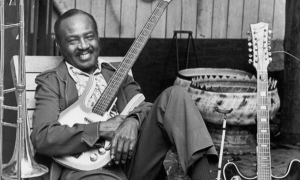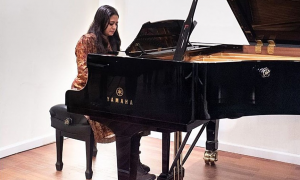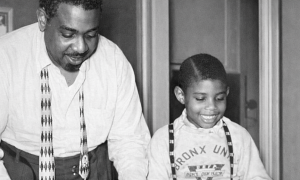Home » Jazz Articles » Under the Radar » A Different Drummer, Part 4: The Zildjian Legacy
A Different Drummer, Part 4: The Zildjian Legacy

Courtesy Zildjian Archive
During W.W. II there was the uncertainty of whether Avedis's sons would even return from the war. Consequently, Avedis wrote down the 'secret alloy formula' for the very first time and kept the document in the company safe. When Armand safely returned home, his father tore up the document.
—Cady Zildjian
A Brief History of Cymbals
In 1986, archeologists from the University of California, Berkeley discovered a cuneiform tablet, dating to 2000 B.C.E. from present-day Iraq, containing fragmentary instructions for performing and composing music in harmonies of thirds, written using a diatonic scale. Musical systems developed in the ancient literate cultures, including Mesopotamia, Persia, Egypt, and China, were characterized by basic notes and scales. The systems on notation have been subject to widely varying interpretations. Because of their ingredients, cymbals survived for thousands of years, and even those of ancient Egypt closely resemble present-day instruments. The British Museum of London has two pairs of cymbals about five inches in diameter from around 100 BCE. The formal history of cymbals can be traced to the Mesopotamian region of 671 BCE. In ancient Egypt and throughout Mesopotamia, dancers and musicians played finger cymbals. Some were larger and indistinguishable from hand cymbals in design.The geographic origin of cymbals is uncertain, but there is strong evidence that ancient Turkey was the primary source. Certain unique types of cymbals such as manjira, tingshas, and sagats may have been developed in other regions, but the most familiar disc-shaped instruments with a bell center came from the Persian area. Traditional Chinese cymbals were without a bell or with a squared-off bell, convex shoulders, and a wide flat rim. Hieroglyphs indicate that ancient cymbals of Northeast Africa may have been variations of bells and singing bowls. Cymbals were probably first used for dances, religious ceremonies, and military purposes and by beggars to attract attention. Prehistoric Bronze Age (c. 3300—1200 BCE) cymbals may have functioned as shields and noisemakers meant to frighten adversaries. Making a natural transition to military marching bands, the cymbal was introduced to the janissaries beginning in the 1200s. The traditional cymbal was incorporated into European music by the 17th century. Still primarily used by military bands, the instruments became a staple of European orchestras in the mid-18th century and took on a more prominent role in the 19th century. Clash cymbals, also called hand cymbals, were the type of cymbal used throughout the Middle Ages and into 19th century marching bands and orchestras. In 1851, Avedis II introduced the Zildjian name to his cymbals at European trade shows. Before that time, they were referred to simply as Turkish cymbals.
As Dixieland and early jazz emerged in the twentieth century, cymbals played a limited role in the drum kit. The bass drum had a small cymbal attached to the drum rim and was struck with an arm attached to the bass pedal. By 1920, the standard kit included a Turkish cymbal and a Chinese cymbal. Later in that decade, coinciding with the development of Chicago-style jazz, the cymbal was frequently choked for accents and used for time-keeping. The snowshoe, and the precursor of the hi-hat, called the "low-boy," first appeared in the mid-1920s. The low-boy, sat ten to twelve inches off the floor, was operated by a pedal that brought the cymbals together as the hi-hat does. The modern hi-hat first came into use around 1927, raising the cymbals to about twenty-five to thirty-five inches.
The other basic suspended cymbals, ride and crash, followed in the late 1920s but without the modern designations that had not yet been established. In a Kenny Clarke interview in the Feb. 1984 Modern Drummer, the influential drummer said that in the mid-1930s, there was still resistance to the ride cymbal by big band leaders. Clarke found that the ride rhythm didn't begin to see widespread acceptability until 1940 when he was playing Minton's in Harlem. For a time, Clarke backed off the hi-hat altogether and focused on the ride. In Hugo Pinksterboer's The Cymbal Book ( Hal Leonard, 1993), the author describes the challenge faced by Armand Zildjian when Gene Krupa approached the cymbal maker in 1933. Cymbal diameters were smaller at the time; weights, more limited. The unnamed cymbals were randomly used as either a crash or a ride. Krupa wanted a more dense sixteen-inch cymbal, and Zildjian was concerned that the leather belt-driven milling process could not accommodate the request. Zildjian, however, came up with a suitable solution.
There are four major manufacturers of cymbals globally, with Zildjian being the largest, oldest, and most successful. Toomas Paiste began producing the cymbals that bear his name in 1906 Saint Petersburg, Russia. The business grew and frequently moved in the first half of the twentieth century, first to Estonia, then Poland, Germany, and in 1957, to its present location in Switzerland. Roland Meinl founded Meinl in 1951 in Germany. For three decades, the company produced only low-budget cymbals, but in 1984 Meinl launched a professional-level line. Sabian, founded in 1981, is hardly an upstart. The second-largest cymbal manufacturer was founded by Robert Zildjian when he struck out on his own. Sabian is based in Meductic, Canada, a small village located along the Saint John River in southern New Brunswick.
The Zildjian Story
Avedis I began making cymbals for the Mehter, the Ottoman military band that also played the davul, a large double-headed drum played with mallets. In addition, Zildjian manufactured instruments for Greek and Armenian churches, Sufi dervishes, and finger cymbals for the Ottoman harem dancers. When Avedis passed, the proprietary formula was handed down through several family generations. Avedis II was instrumental in taking the Zildjian brand to an international market in the mid-1800s. When he died in 1865, his brother Kerope II took over and introduced the renowned K Zildjian line that continues to present times. Kerope's namesake cymbals are the essence of timeless, shadowy, and intricate ambiance; they stand on their own.In the face of Armenian oppression, Avedis III left Turkey and the family business in 1909, emigrating to the Boston area where he established a confectionary business. The reins of the cymbal business in Turkey were passed to Kerope's nephew Aram Zildjian. To understand the circuitous journey of Aram, it is necessary to probe a part of Middle Eastern history that has often been ignored. Christian Armenians faced trying lives under the Ottoman Empire, where the dominant Kurdish nomads and Muslim-favoring legislation marginalized them. By the seventeenth century, Armenians had begun establishing enclaves within Istanbul, and a small number of families were able to secure influential positions in business and government. Educated and urbane, this emerging group of Armenians quickly drew backlash from the majority, who feared competition and disloyalty to the empire.
Armenian activist groups sprang up to protect their people, but they didn't inspire widespread support. Under several pretenses for aggression, Ottoman troops and Kurdish tribesmen massacred hundreds of thousands of Armenians in the region between 1894 and 1896. At the 1914 outset of World War I, the Young Turks joined with the Central Powers—Germany and Austro-Hungary—against Great Britain, France, and Russia. Because Armenians lived in both Russian and Ottoman-controlled territories, they fought on both sides of the conflict. The Ottoman Empire fared badly in the war, losing almost all of its European territory and the finger-pointing aimed at the Armenians whom the Young Turks accused of betrayal. Marched to concentration camps in the Syrian desert, many died in route; others were routinely executed by military officials, Kurds, and Russian Circassians. It's estimated that from 1894 to 1917, up to one and a half million Armenians were murdered in the Ottoman pursuit of ethnic cleansing.
Sultan Abdul Hamid II was known as "The Bloody Sultan." Before he was deposed, there were numerous attempts to assassinate him. Aram Zildjian was infuriated by Turkish atrocities against Armenians. He joined the Armenian Revolutionary Federation, a nationalist and socialist political party founded in 1890 in Russia. The group tracked the movements of Sultan Abdul Hamid II. They duplicated his personal carriage and, on July 21, 1905, planted a bomb that would detonate as the Sultan left prayers at the Yıldız Mosque in Istanbul. Hamid II was delayed in leaving, and the attempted assassination failed though dozens died in the explosion. Turkish police were able to trace the Armenian collaborators, and Aram Zildjian went into exile in Bucharest. In Aram's absence, Kerope (II) Zildjian and then his daughter Victoria managed Istanbul production. Aram set up another cymbal shop in Bucharest and remained in Romania until 1926 when he returned to Turkey and resumed his role in the family cymbal business.
The American Experience
Avedis Zildjian (Avedis III) was a hard-working and perceptive businessman, fluent in five languages, and aware of the limitations of remaining in Istanbul. In 1908, he emigrated to the United States, where he found work with an Armenian candy maker in the Boston area. New England—especially Boston— reigned as the American confectionery capital from the 1700s through the mid-1900s. Avedis III later founded his Commonwealth Confectionary Company, raised a family, and became an American citizen. Meanwhile, Aram Zildjian expanded the cymbal business in Turkey and successfully exported instruments to the U.S. market. Nearing retirement, he reached out to Avedis III, requesting he return to Istanbul and take his place as head of Zildjian. Avedis had no wish to return to the political environment of Turkey but convinced Aram to come to the U.S. and supervise the transition of production to Massachusetts. In 1929, at the start of the Great Depression, the Avedis Zildjian Company and its three employees launched their company. Avedis III was the first to develop drum-set cymbals and give cymbals names such as ride, crash, splash, and hi-hat. The Turkish arm of the Zildjian business—K Zildjian—continued to operate independently in Istanbul until the Massachusetts branch bought them out in 1968. The Istanbul factory continued to operate until closing in the late 1970s.Zildjian's American journey coincided with the development of modern jazz. Drummers such as Gene Krupa, Chick Webb, and Buddy Rich used Avedis Zildjian cymbals. K. Zildjian cymbals thrived in the 1950s, favored by Elvin Jones, Tony Williams, Art Blakey, Philly Joe Jones, Chico Hamilton, Mel Lewis and others. The appearance of The Beatles, on The Ed Sullivan Show in 1964, with Ringo Starr using Zildjian cymbals, drove a significant increase in sales. A second production facility was added in Canada in 1968 to adapt to the upsurge in demand. Zildjian's success did not go unnoticed by competitors. Agop Tomurcuk and Mehmet Tamdeger began working for K Zildjian in the 1950s before they were in their teens. Thirty years later, they partnered, forming Zildjiler Cymbals. In 1984, "Zildjiler" came to the U.S. market. Their brand name and logo were designed to mimic Zildjian's. Losing in a legal challenge brought by Zildjian, they were forced to change their name, becoming Istanbul Cymbals. In 2021 there are dozens of smaller cymbal companies besides the big four. However, it is estimated that Zildjian holds forty to fifty percent of the U.S. market. In 2010, Zildjian expanded further with the acquisition of the Vic Firth Company and the Mike Balter Mallet company in 2018. With those acquisitions, Zildjian now offers a full range of drumsticks and percussion mallets in addition to a line of professional in-ear monitors.
With offices in Los Angeles and London, the Norwell, Massachusetts-based Zildjian has become a community-facing organization offering educational programs, the Kerope Zildjian Scholarship Competition, live performances, and interviews. And long before most of corporate America was opening C-suite doors to women, the Zildjian company had bypassed the glass ceiling. In 1976, Avedis III brought his granddaughter, Craigie Zildjian, into the business, beginning a new tradition that continues in 2021. Today, she is the Executive Chair of the company and Cady Zildjian, who earned an M.B.A. from Babson, sits on the company's Board of Directors. I interviewed Cady in May 2021.
Cady Zildjian
All About Jazz:The Avedis Zildjian Company, known as Zildjian, is one of the oldest companies globally and the oldest musical instrument company still in existence. How is that legacy reflected in the cymbals that Zildjian produces today?Cady Zildjian: Zildjian's legacy is evident in everything we produce today. For example, Zildjian still uses the same centuries-old alloy to cast cymbals. As in the previous 400 years, Zildjian cymbal makers are skilled laborers and craftsmen who complete an intensive apprenticeship program. Zildjian has always treated its manufacturing process as an art. We continue to prioritize artist involvement as we create new sounds.
Of course, family is one of Zildjian's greatest legacies. The family has operated the business for 15 generations, with no intentions of stopping anytime soon. But, the Zildjian family is really much bigger. It includes our employees, artists and crucial business partners.
AAJ: The company's early history dates to the seventeenth-century Ottoman Empire. The Sultan conferred the Turkish-Armenian name of Zildjian (cymbal smith) on the Armenian metalsmith and alchemist Avedis. The Sultan later permitted Avedis Zildjian to start his own business. Was there ever a time in the last four hundred years where the company's direction was in doubt?
CZ : There have been uncertain times in Zildjian's history. For example, in 1868, the Istanbul foundry suffered a serious fire which made the family think to relocate the business to Paris. Sultan Abdulaziz did not want to see the business leave Istanbul. So he ordered that "everything necessary be done to help the Zildjian family whose quality of cymbals is unrivaled throughout the world." (translated from the Ottoman Archives)
Then in the 1920's there was a serious succession issue. Aram Zildjian, who ran the business during that time period, was a bachelor, who had no children. The logical successor was Aram's nephew Avedis III. However, Avedis III had emigrated to the U.S. in 1909 and was running a successful candy business in Massachusetts. When Aram asked Avedis to return to Turkey and take over the cymbal business, Avedis said he did not want to leave America. It was then decided to bring the business to America, but only after Sally, Avedis's wife, and her family offered to fund the move.
Finally, the direction of the business was in doubt during W.W. II. F.D.R. had established the War Production Board which allocated scarce resources like copper and tin. The WPB had the ability to prohibit manufacturing which was non-essential to the war effort as well as to convert businesses from peacetime work to war needs. Fortunately, the Zildjian Company continued to receive allocations of metal to make cymbals for the Armed Forces and the British Admiralty.
In addition, during W.W.II there was the uncertainty of whether Avedis's sons would even return from the war. Consequently, Avedis wrote down the 'secret alloy formula' for the very first time and kept the document in the company safe. When Armand safely returned home, his father tore up the document.
The Zildjian family remains committed to producing the world's best cymbals. Being flexible and embracing change is key to maintaining the company's direction.
Cymbals and drums had great symbolic significance in the Ottoman and Persian empires and the later republics of Turkey and Armenia. Percussion instruments were given as gifts to acknowledge the transfer of power to a new dynasty and represented a connection between the religious and secular worlds.
AAJ : What is the Zildjian philosophy behind percussion as being more than music, impacting the innovations you create as a company?
CZ : As Remo Belli always said, percussion is more than just musical entertainment. Percussion or rhythm can also be a tool for healing. For example, I have witnessed stroke victims who lost their ability to walk. But once they heard the rhythm of a drum or a tune, their brain was able to remember the cadence of walking. In such situations, music therapy can be even more helpful and faster than physical therapy.
AAJ: Avedis III left Turkey for the Boston area in 1909 but to start a confectionery business while the cymbal business remained in Turkey. It would be almost twenty years until Avedis III, his brother, and his uncle began manufacturing cymbals in Quincy, Massachusetts. What brought about that transition? And did part of the business remain in Turkey after production began in the states?
CZ : Avedis III was the first of the Zildjian family to come to the United States at 19 years old. He prospered in the U.S. and, along with his wife, was able to fund moving the business across the Atlantic. For a short time after the relocation, members of the extended Zildjian family that remained in Istanbul produced cymbals in the old foundry until the business was firmly established in the United States. All production and trademarks were soon consolidated at the Quincy, MA location for quality control and logistical reasons.
AAJ : When Ringo Starr appeared on American television in the 1960s, playing Zildjian cymbals, the boom in orders necessitated building a second manufacturing facility. The Beatles helped expand the market for Zildjian in the U.S. and U.K. but did that exposure have a global impact on the company?
CZ: Zildjian was already an international company by the time Beatlemania hit. The fascination with British pop culture fueled the company's European and Asian sales, as well as driving up domestic demand. It took Zildjian years to fulfill the backorders created after Ringo Starr and the Beatles appeared on the Ed Sullivan show in 1964.
AAJ: The Zildjian Alloy Snare was Noble & Cooley and Zildjian's innovation and utilizes proprietary Zildjian alloy materials. In what other partnerships is the company engaged?
CZ: The Zildjian and Noble & Cooley snare was a very special collaboration to commemorate the company's 375th anniversary. Since its release, it has become one of the most sought-after snare drums on the collectors' market. We love working collaboratively with like-minded creators inside and outside of the music industry, and your readers will be glad to know that we do have a few limited edition items coming in the near future! Unfortunately, it's too early to share more details, but we're very excited about them and we're sure drummers and collectors will be as well.
AAJ: How has the cymbal manufacturing process changed over the past one hundred years?
CZ: It's true that the cymbal manufacturing process has evolved greatly at the Zildjian foundry over the past century. Today's Zildjian cymbals are more musical and consistent than ever (and our craftspeople are safer than ever), thanks in part to our highly sensitive temperature-controlled ovens, advanced machine hammering, robotics in printing and buffing, and much more. It's worth noting, however, that none of these innovations have fundamentally changed the art of cymbal making. Raw metals are still smelted into the Zildjian Alloy, following the same secret process discovered by Avedis I, 400 years ago. Every cymbal still needs to be carefully heated, rolled, tempered, hammered, lathed and tested. As technology advances, these key pillars of the art of cymbal making remain constant.
AAJ: Is it true that no two ride cymbals sound exactly the same? Or is that an outdated notion?
CZ: Yes, this is true! While today's cymbals are generally much more consistent than cymbals made a century ago, there is still a wide degree of natural variation within any given model, which we believe is what drummers are looking for. In some cases, we intentionally design cymbals to have a wider degree of variation model-to-model. These are typically higher-end cymbals, such as K Constantinople and Kerope, made for the drummer who is looking for a more distinct cymbal sound to call their own.
AAJ: Approximately how many people has Zildjian employed at various times in their history?
CZ: This is a tough question! Zildjian started its U.S. business in 1929 with 7 cymbal smiths, mostly from Istanbul. Today we employ over 200 people. Our factory runs two shifts and has an average of 80 employees.
AAJ: Zildjian's relationship with jazz began in 1930 with its association with Gene Krupa, and soon after, with Chick Webb and Papa Jo Jones. What innovations came out of these contacts?
CZ: Both Avedis and Armand had a famously close, lifelong friendship with Gene Krupa. At the dawn of the jazz era, Avedis III had just opened Zildjian's first factory in the United States. His relationship with Gene was instrumental in the development of the early A's that changed the face of jazz music and elevated the role of the drummer. Up until the 30s, cymbals were mostly small and very thin, thus most of the time in the ensemble was played on a splash, or "sock" cymbal. Larger sizes were hand cymbals and generally too heavy to be played on the evolving drum kit. Avedis having talked and listened to drummers and what they needed as jazz evolved into the swing era, was able to produce larger cymbals that were thinner than the hand cymbals that were readily available. This led to the ride cymbal that we know today, and allowed the timekeeping to move to this particular cymbal that was able to "ride" above the band. Most notable is Papa Jo's use of the ride cymbal in the "Great American Rhythm Section" of the Count Basie Orchestra.
AAJ: In the early 1980s, Zildjian brought back their handmade 'K' line (named for Kerope Zildjian). What role did drummers Elvin Jones and Tony Williams have in that process?
CZ: Elvin and Tony were incredibly influential in bringing back the American made "K"s of the 1980s. At the time, they were arguably the two most in demand jazz drummers, who were continuing to shape the genre as it came out of the bop era. Up until this point, all of the cymbals made in the U.S. were of the "A" style, which had a much cleaner and defined sound. Tony and Elvin through their career used Istanbul made "K"s, which have a much darker and more complex sound (i.e. Tony on Four and More and Elvin on A Love Supreme) So as music was evolving and cymbals along with that, the company turned to their Istanbul history to make a darker and more complex instrument which is synonymous with jazz. Their input and expertise lead to the American Zildjian "K" cymbals and were the launching point of the "K"S we have today.
AAJ: Who are some current jazz artists that are using your brands?
CZ: Zildjian is proud to support notable artists such as Eric Harland, Kendrick Scott, Karriem Riggins, Jeremy Dutton, Marcus Gilmore, Kenny Washington, Lewis Nash, and Bill Stewart.
AAJ: In 2010, Zildjian merged with top drumstick maker Vic Firth. Along with the Firth brand, Zildjian markets an "Artist Series" of drumsticks. Are the "Artist Series" drumsticks manufactured by Vic Firth or a separate entity?
CZ: As two Boston-based leaders in the music industry, with shared values and a family approach to business, it should come as no surprise that the Zildjian and Firth families have been close for decades. Prior to the 2010 acquisition, Zildjian Drumsticks were manufactured at the Vic Firth factory in Newport, ME. Today, all Zildjian, Vic Firth, and Balter drumsticks, mallets and other implements are designed and made in the Zildjian Newport factory. Vic Firth is currently constructing a new, state of the art manufacturing facility for drumsticks and mallets. All production will transfer to the new facility this summer, August 2021.
AAJ: Zildjian recently added educational content in lessons, interviews, performances, and more. Are these features inspired by the COVID-19 void or something that had been in the works prior?
CZ: Expanding Zildjian's online educational content has been a focus of the past several years, although the COVID-19 pandemic absolutely spurred us to accelerate our lesson plan! We immediately saw that musicians who were quarantined at home and unable to play with their fellow musicians still had an urge to play, learn and improve their skills. From short-form content like #InstaLessonz, to transcriptions of Zildjian Live, to lessons geared towards people picking up the sticks for the first time, we've had great feedback on our educational content in 2020. This has obviously been an incredibly tough year for everyone, but we hope that we've been able to help people make the best of their individual situation, and help them continue to enjoy music during this difficult time.
AAJ: Of the clients who have approached Zildjian for custom-made cymbals, who were some of the most notable?
CZ: There are countless luminaries who have worked with us over the years to create unique sounds. There are a few collaborations that stand out.
In 1991, we partnered with Vinnie Colaiuta to create the famed A Custom line of cymbals. The main goal of this line was to take the famous A Zildjian line, and take it a step further in sound and to create something that was much more in the realm of where music was heading in the 90's. These cymbals were the first of their kind developed to be bright and cutting, yet beautiful and lush at the same time. They incorporate the beauty of "A" Zildjians, but add another level of character to the sound with their smooth brilliant look and sound. These cymbals are just as popular today as they were in the early '90s and continue to stand the test of time, being used today in every genre from rock, to pop, to jazz.
Bill Stewart and the development of the Dry Complex and Dry Complex II ride cymbals is another important collaboration. When these came out in 2004, they were one of the most unique cymbals we had ever made. Jazz was in a period of evolution and there was a want from players for something cutting, dark, and extremely complex. This cymbal was just that. It was a base of a K Custom, but with added hammering, and incredibly high shape and a weighting distribution between the top and bottom of the cymbal like nothing we had done before.
This cymbal filled the needs of what musicians wanted at the time, and due to its wild success, a second round was released a few years later, playing on the same vibe as round 1. As things change and the needs for sound, this cymbal was discontinued, but still today we continue to make them in small batches that are released periodically at industry events.
In 2004 we were approached by the great Akira Jimbo who was currently playing the "K" line but was looking for more crushability out of the cymbals. He loved the cutting bell and definition the "K" line produced, but was looking for the crash to be more lush. Look was also a factor, and at the time he played a lot of brilliant cymbals. The R&D department decided the best way to go about this was to take an existing "K," polish it, and lathe the outer edge of the cymbal. What we found was that this kept the integrity of the bell and the cutting definition, but by removing weight where the cymbal is crashed, that allowed it to open up more and achieve that beautiful "whoosh" Akira was after. These cymbals are still well loved today, especially in the fusion world and mix that concept of traditional "K" construction and new world innovation.
Tags
PREVIOUS / NEXT
Support All About Jazz
 All About Jazz has been a pillar of jazz since 1995, championing it as an art form and, more importantly, supporting the musicians who make it. Our enduring commitment has made "AAJ" one of the most culturally important websites of its kind, read by hundreds of thousands of fans, musicians and industry figures every month.
All About Jazz has been a pillar of jazz since 1995, championing it as an art form and, more importantly, supporting the musicians who make it. Our enduring commitment has made "AAJ" one of the most culturally important websites of its kind, read by hundreds of thousands of fans, musicians and industry figures every month.























